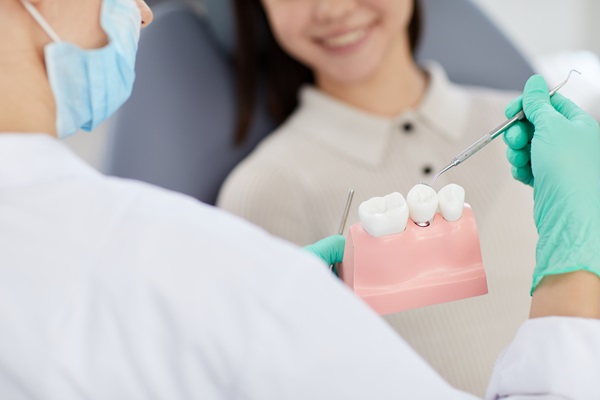Maintaining Oral Health with Dental Crowns and Bridges

A beautiful smile is indeed a powerful asset. However, others may feel uncomfortable having a missing or damaged tooth. Good thing modern dentistry offers solutions like dental crowns and bridges. They are one of the perfect options for restoring both aesthetics and functionality.
These fixes can be pretty strong. But, it doesn’t mean they will not wear out. Let’s see some practical tips to keep our dental crowns and bridges from falling off.
Getting to Know Dental Crowns and Bridges
What Are Dental Crowns?
Think of a dental crown as a cap. Dentists usually place it over a damaged or decayed tooth to restore its shape, size, strength, and appearance. Dental crowns are typically used for teeth that are cracked, weakened, or decayed.
They are often made from materials like porcelain, ceramic, or metal, giving them the durability they can provide.
What Are Dental Bridges?
Dental bridges are used to replace one or more missing teeth. They have one or more fake teeth (pontics) that are held in place by crowns on the nearby natural teeth or implants. Bridges are typically used to fill in the gaps left by missing teeth, making your smile look and work like it should again.
Tips for Maintaining Dental Crowns and Bridges
Practice Good Oral Hygiene
Brushing
We all know the drill—brushing our teeth twice a day. We know you’ve heard it a million times, but it is truly the holy to keep our teeth healthy. Use fluoride toothpaste when brushing your teeth, and ensure to brush all surfaces of your teeth. Don’t forget to brush around your crowns and bridges too. Always use a soft-bristled toothbrush, so you don’t damage your dental work as well as the supporting teeth and gums..
Using interdental brushes
We get it, cleaning in between the teeth might feel like a chore sometimes, but trust us, it’s worth it! This extra step can get rid of plaque and bits of food stuck between your teeth, including around your crowns and bridges. The number one cause of crowns and bridges getting problems is the bacteria that grows in between the teeth. This bacteria gets trapped there as people often forget to clean it. Over time it damages the crown and the tooth, causing problems such as recurrent tooth decay, broken crowns or loose crowns.
Ask our dentists to help fit you for the ideal size of interdental brush for your teeth.
Regular Dental Check-Ups
Professional Cleanings
Brushing and flossing at home will not suffice, so make sure to pay your dentist a visit for regular check-ups and professional cleanings. These visits are important for keeping your teeth in top shape. They can help you get rid of plaque and tartar buildup that you might miss when you’re brushing at home.
Monitoring Dental Work
During your check-ups, your dentist will take a good look at your crowns and bridges to make sure they’re holding up well. They will check if there are any signs of damage, decay, or gum issues. They may even make any tweaks when needed to keep your dental work doing its job properly.
Avoid Damaging Habits
Hard Foods
Avoid biting down on hard foods or objects. Steer clear from Ice, hard candies, or popcorn kernels to avoid damaging your crowns and bridges.
Teeth as Tools
Don’t use your teeth as tools to open stuff like packages or bottles. It might seem handy, but it can really mess up your dental work (and your real teeth too!).
Bruxism
Bruxism is when you grind or clench your teeth during your sleep. If this continues, you might want to get a custom night splint. This can help you protect your crowns and bridges from the pressure caused by grinding.
Maintain a Healthy Diet
Nutrient-Rich Foods
A healthy diet is good not only for your physical health but also for your oral health. Your teeth can benefit from foods like dairy products, leafy greens, and almonds. These are packed with calcium for stronger bones which then provide a stronger foundation for the teeth.
Limiting Sugary and Acidic Foods
Sweets can be a treat, but remember that anything too much is bad. Sugary and acidic foods can compromise your tooth enamel, making them at risk for tooth decay around your crowns and bridges. You wouldn’t want that, right?
Address Issues Promptly
Signs of Problems
Look out for any signs of issues with your crowns and bridges. This may include sensitivity, discomfort, or a loose fit. If you notice any problems, contact your dentist right away.
Early Intervention
If you have any issues with your dental work, address them right away. Getting them checked can prevent more serious problems down the line. Early intervention can save you time, money, and discomfort by keeping your crowns and bridges in optimal condition.
Special Care Instructions
Caring for Temporary Crowns
If you have a temporary crown while waiting for your permanent one, be extra careful with it. Avoid sticky and hard foods that could dislodge the temporary crown. Always maintain good oral hygiene around the area.
Cleaning Around Bridges
Cleaning around dental bridges can be challenging, especially in the area under the pontic. The use of interdental brushes will keep this area clean and free from plaque buildup.
Keep Your Crowns and Bridges in Top Shape
Surely, dental crowns and bridges are great life savers for teeth restoration. So, whenever you get a hold of them already, remember to take care of them well. Be proactive in keeping them clean and healthy to preserve them for as long as possible. Following these tips can help you keep your crowns and bridges in top shape, and your health optimal.
For your dental crowns and bridges, get an experienced team to help you maintain them. Whitehorse Dental should be the only partner you should seek to maintain your oral health. Contact us today at (03) 8838 8820 for a dental appointment.

